Repairing snapped booms, treating oil-slicked sand: Oil spill clean-up efforts continue a week on
CNA observes how containment booms are laid and what it takes to treat the toxic oil-soaked sand collected from affected beaches.
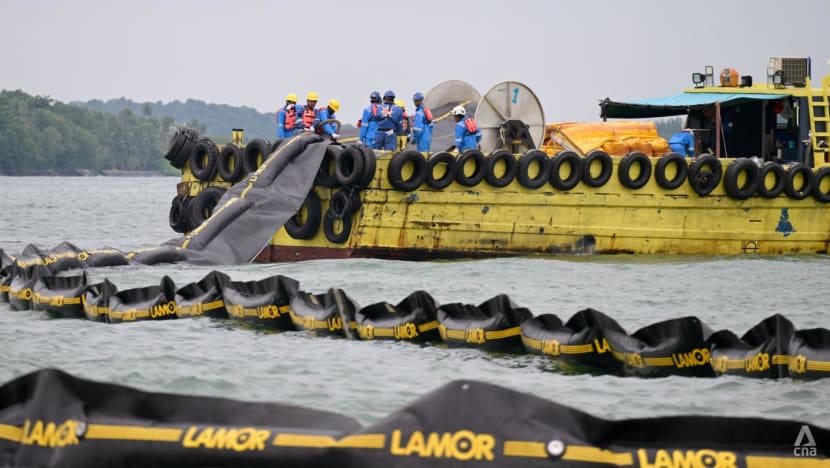
Workers from T&T Salvage Asia deploying oil booms into areas affected by the oil spill. (Photo: CNA/Marcus Mark Ramos)

This audio is generated by an AI tool.
SINGAPORE: A week after 400 tonnes of oil spilled into Singapore's waters, there is still work to be done to mop up - at sea and on land.
Containment booms off Sentosa have had to be repaired and reinforced after turbulent weather caused some of them to snap.
One clean-up company brought in additional manpower from abroad to beef up its operations. Plus, the toxic oil-soaked sand collected from the affected beaches has to be carefully processed at a treatment plant.
The spillage occurred on the afternoon of Jun 14 after a Netherlands-flagged dredger hit a stationary bunker vessel, causing oil from the latter's damaged cargo tank to spill into the water.
That evening, containment booms were deployed by T&T Salvage Asia to block off the entrances at the lagoons of Sentosa’s beaches.
Those red-coloured rigid booms which were first set up are easier and faster to deploy, the firm's managing director Captain Anuj Sahai explained on Friday (Jun 21). However, they are not as strong and effective as the more heavy-duty booms which have since been in place.
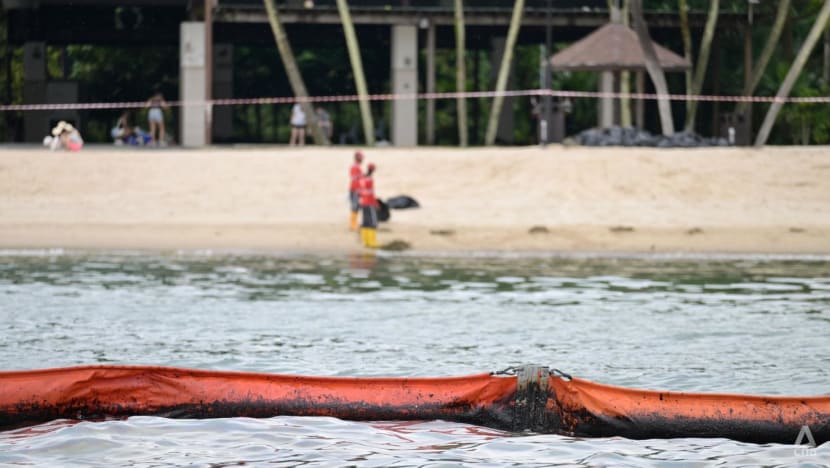
CNA observed a team from T&T Salvage Asia at work on Friday, laying a 200m-long black-coloured containment boom along the external coastline of Siloso Beach.
“It was bad weather, very strong thundery showers early in the morning. So one or two booms snapped, but it was immediately taken care of,” Capt Anuj said, noting that the larger boom was being deployed only as a precaution.
Some extent of damage such as wear-and-tear is natural and already factored in as considerations when deploying booms, he explained.
The new boom is made up of 3m-long segments that have to be completely inflated with air so it can float on the water. It is heavy and requires more manpower and coordination to deploy, said Capt Anuj.
“These are bigger booms. They are much more sturdy and stronger. They will last much longer. But takes also a little bit more time to deploy as well,” he added.
Each 3m segment weighs about 100kg when completely inflated. It is launched off a boat and towed into position by a smaller raft that can move faster and get closer to the shore.

T&T Salvage Asia has deployed about 85 people for its clean-up operation. About 20 of them were brought in from abroad “because this was a massive spill and there were so many locations to look at”, said Capt Anuj.
The crew members are from Singapore, the Philippines, India, Ecuador and Argentina, he said. Three teams work around the clock.
“Everybody has about 10 to 15 years of solid experience. They know exactly what needs to be done. They don't need to be taught,” said Capt Anuj, who has been in the oil spill response sector for about 20 years.
He added that physical fitness is a crucial aspect of the job, and that the risk of injury is very real.
In Singapore where the current and tides are strong, it can be difficult to maintain the boat's position during deployment operations, he noted.

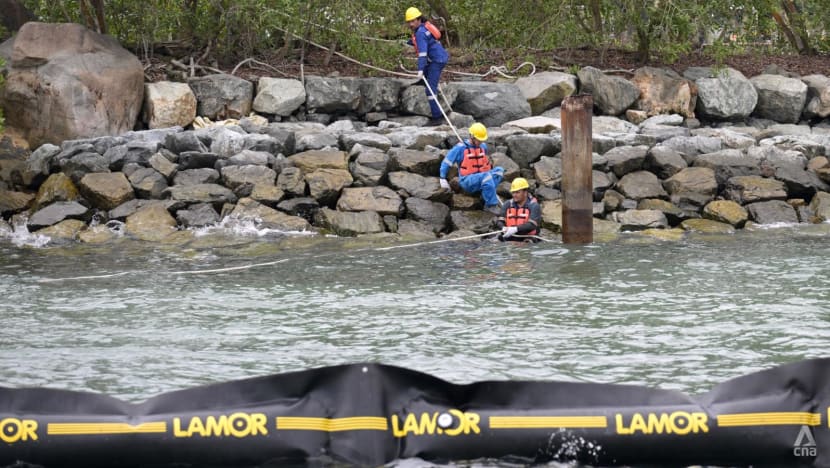
Capt Anuj's firm is in charge of the stretch between Labrador Park and Sentosa Cove, along with islands further south like St John’s Island. It has laid out about 2.5km of booms so far.
“The effect of wind and weather is quite strong over here, especially when you're close to Sentosa. So we have to take a lot of precautions for that,” he said.
There are different considerations for each location. At Sentosa, for instance, the venue of the Wings of Time show was a factor.
“It has a lot of protruding structures (and) steel structures, so they might puncture these kinds of booms. So then we immediately have to go and then supplement with reinforcements,” explained Capt Anuj.
HOW OIL-SOAKED SAND IS TREATED
CNA was also invited to observe how oil-soaked sand collected from the beaches of East Coast Park and Sentosa is being treated.
After sand is bagged by cleaners at the beaches, it is transported to a treatment plant operated by Mencast Offshore and Marine at Penjuru Road in Jurong to be rid of oil.
Workers unload the oil-soaked sand at a sheltered solid waste storage area, which has a 300- to 400-tonne capacity.
Oil-soaked sand, soil and debris such as planks of wood, branches, plastic bottles and plastic bags from East Coast Park and Sentosa are unloaded there.
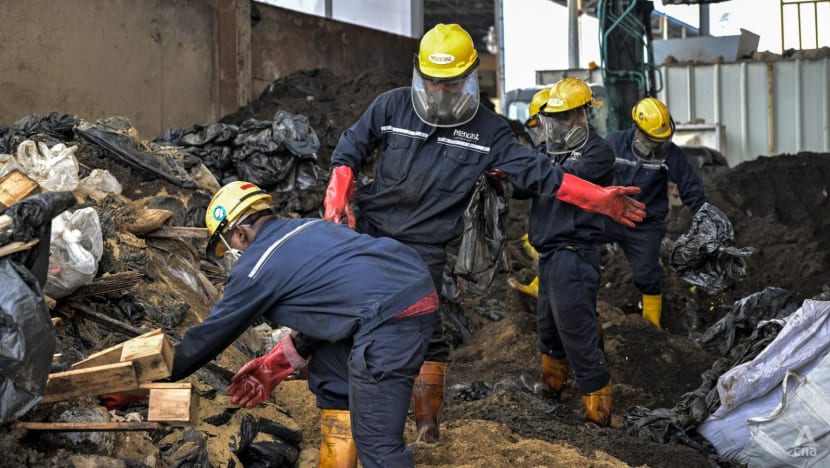
Ms Irni Masnita Mohamed Anis, the sales and business development manager at Mencast, said that since Tuesday, 10 trucks of waste have arrived at the facility - eight from East Coast Park and two from Sentosa - with about 140 tonnes of sand and debris brought in from both locations.
To protect themselves from the toxic fumes from the oil, workers wear heavy-duty gas respirator masks while removing the sand from plastic bags in the storage area.
An excavator then scoops up the sand and dumps it into a large machine called a crusher.
That is where the soil clumps will be crushed and then sieved to remove foreign materials like plastics. The sifted sand will then be brought to a heating drum via a conveyor belt. It will be heated at 550 to 600 degrees Celsius for about 30 to 45 minutes.
“Due to the heat, it removes the oil,” said Ms Irni.
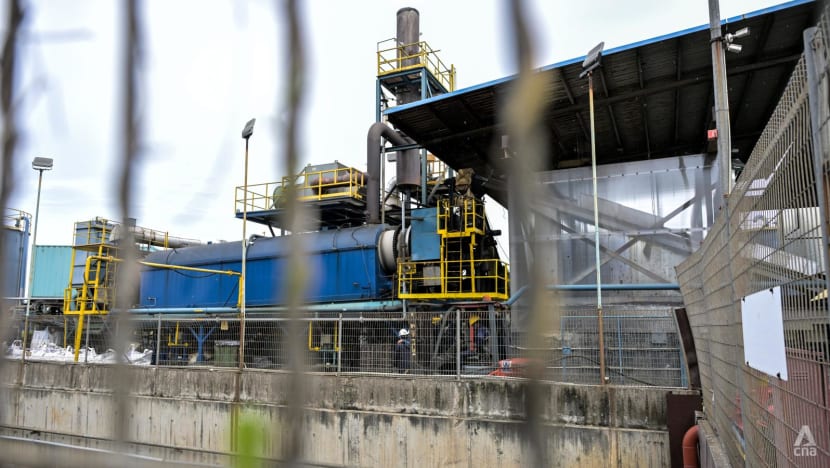
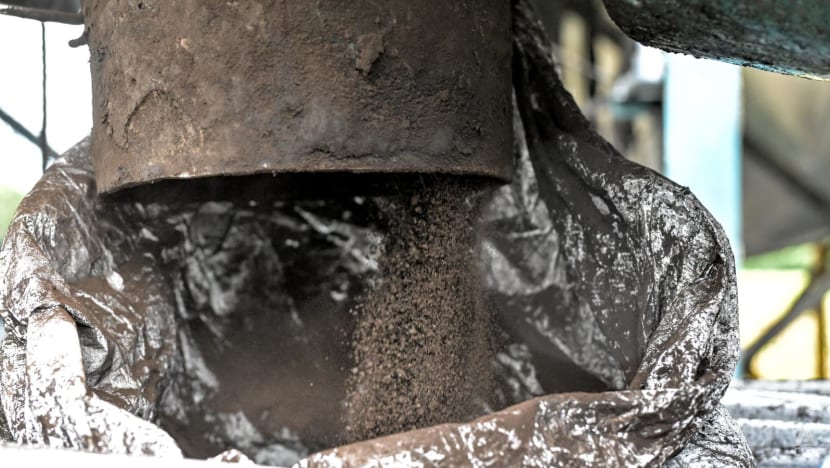
Typically, unprocessed sand has about 2 to 5 per cent of oil, but the treated sand is tested to have just 0.1 per cent of oil content.
The facility has been treating the sand since Thursday, and so far, about 10 to 12 tonnes of sand has been treated.
The treated sand will then be assessed for future use such as fillers in sandbags, or potentially mixed in concrete.
“All these (recovery options) come with analysis and tests which have not been finalised yet,” said Ms Irni, adding that discussions will be held with the owners of the sand as to what they prefer to do with the waste.
She did not disclose how much the sand treatment would cost, but said that clients will be charged “market rates”.
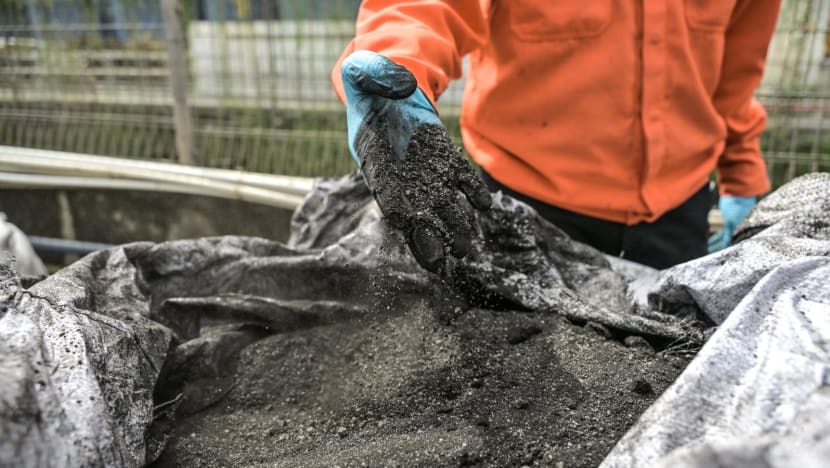
The oil that is removed from the sand is also recycled and sold to Mencast’s clients as recovery oil, typically after it is reblended with Mencast’s current existing oil.
Asked why the option of disposing of the oil-soaked sand was not considered, Ms Irni said there could be harm to the environment if it were just disposed of carelessly.
“Anything that is contaminated with oil is toxic and needs to be treated in a proper manner,” she said.




















